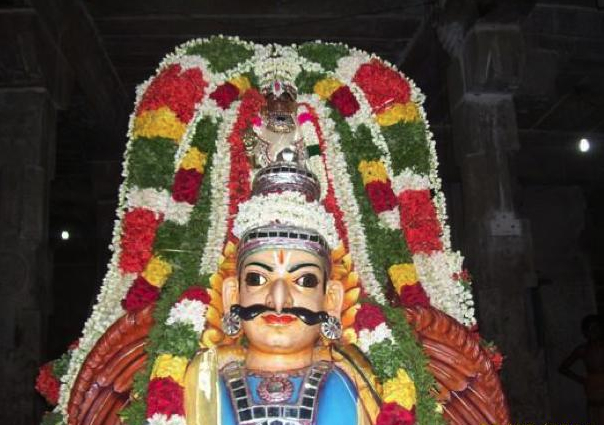GITA 6.20
svadharmaj~nAnavairAgyasAdhyabhaktyekagocaraH .
nArAyaNaH paraM brahma giitaashaastre samiiritaH
This is the opening sloka in Gitartha Sangraham by Acharya Swami Alavandar. He says that Sri Krishna is the Paramatma and to reach Him, bhakti [devotion] is the only way and this is evident from Bhagavat Gita. There is none equal to or above Him. Among all tatva [entities], He is the only true entity. Tatva gyana thu moksha laba, so say the great people. That is, a true understanding of tatva will yield moksham. Lack of this knowledge will push us in the cycle of births in samsaram.Tatva means the true entity. If we do not know the truth, we get into this endless cycle of birth and death. So we have to be in search of the truth. In Srimad Bhagavatham, sage Sukhacharya narrates the chorus of the devas. Sri Krishna, to redeem the sufferings of the devas, got into the womb of Devaki. Realizing this the devas praised the Lord and Devaki. At that time they all say of Sri Krishna as the Truth in all and He dwells as the Truth in all inanimate [achit] matters. He is the Truth inside the Atman [chit]. He is the cause for all true things we see in this world. He graces in the Paramapadam, that is true, always. "We the devotees surrender unto You, the Truth", say the devas. Upanishads when trying to identify the Lord, say He is Satyam, Gyanam, Anantham. Anantham means endless in space, time or place. He can not be bound by any measurement nor He can be told that He was there in the past only. He is present at all times and at all places in all forms. There is no beginning, no middle and no end. Gyanam means He knows all happenings of the past, present and future, at all places and at all times. He creates just by His knowledge [sankalpam]. Sathyam means permanent or everlasting. It does not undergo any change at any time and at any place. 'Avikaraya suddhaya nityaya paramatmane'. His qualities, forms, etc., will never change. So search of truth is search of God. And, He graces in this Kshetram as Sri Sathya Narayana. |
| Sri Satya Narayana Perumal |
Thirumangai Alwar was especially attracted by the Lord here and that is why even while praising the Lord of Thirunarayur [Nachiarkoil] or Nagappattinam or Thirukkannapuram, he mentions this Lord. Brahmam remains illuminating the surroundings like a lamp glowing steadily. Sri Krishna tells in the 19th sloka how a person practicing yoga would be. Sri Krishna uses not the analogy of the hill which is steady, to describe the state of a yogi. Perhaps, a mountain or hill may describe stability but not the glow. Now the 19th sloka:
yatha dipo nivata-stho
nengate sopama smrta
yogino yata-cittasya
yunjato yogam atmanah
nengate sopama smrta
yogino yata-cittasya
yunjato yogam atmanah
As a lamp in a windless place does not waver, so the transcendentalist, whose mind is controlled, remains always steady in his meditation on the transcendent Self.
"As a lamp in a windless place does not waver, so the transcendentalist, whose mind is controlled, remains always steady in his meditation on the transcendent self."
Just like a lamp glows steadily in still air surrounding, the yogi would be seen. Yatha = just like. Yatacittasya = controlled sense organs and mind, yunjata = involved in yoga, yogina = yogi's, atmana = state, sa upamasmrta = that is shown as example. Nivatastho = air-circulationless or still air, dipa = lamp, yatha = just like, nengate = motionless or steady. Atman and its glow is compared to a lamp with glow. If the lamp should not flicker or glow steadily, then there should not be disturbance by air circulation. If, similarly, Atman has to glow steadily, it should not be disturbed by the senses that drag the sense organs and these senses are comparable to air. This 'air' will make the Atman lamp to flicker and will not allow it to be steady. By controlling the sense organs, the mind is able to meditate steadily on Atman. This is the reason why Sri Krishna took for comparison the lamp instead of the hill. Just as to keep the lamp to glow steadily, we provide enclosure, we have to withdraw ourselves from material distractions and remain in an enclosure. Just as periodical addition of oil would ensure the lamp glowing always, we have to do karma yoga periodically and keep the Atman glowing. We can imagine the Lord's image in temples as the enclosure for the lamp. Bhakti or devotion is the oil. Atman will glow steadily and always
(continued)






